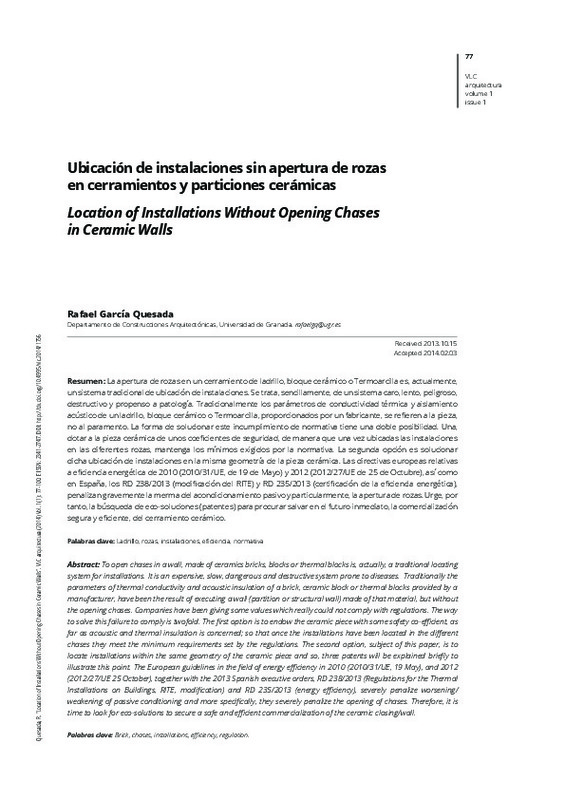JavaScript is disabled for your browser. Some features of this site may not work without it.
Buscar en RiuNet
Listar
Mi cuenta
Estadísticas
Ayuda RiuNet
Admin. UPV
Ubicación de instalaciones sin apertura de rozas en cerramientos y particiones cerámicas
Mostrar el registro sencillo del ítem
Ficheros en el ítem
| dc.contributor.author | García Quesada, Rafael
|
es_ES |
| dc.date | 2014-02 | |
| dc.date.accessioned | 2014-07-31T11:44:40Z | |
| dc.date.available | 2014-07-31T11:44:40Z | |
| dc.date.issued | 2014-03-28 | |
| dc.identifier.issn | 2341-3050 | |
| dc.identifier.uri | http://hdl.handle.net/10251/39226 | |
| dc.description.abstract | [EN] To open chases in a wall, made of ceramics bricks, blocks or thermal blocks is, actually, a traditional locating system for installations. It is an expensive, slow, dangerous and destructive system prone to diseases. Traditionally the parameters of thermal conductivity and acoustic insulation of a brick, ceramic block or thermal blocks provided by a manufacturer, have been the result of executing a wall (partition or structural wall) made of that material, but without the opening chases. Companies have been giving some values which really could not comply with regulations. The way to solve this failure to comply is twofold. The first option is to endow the ceramic piece with some safety co-efficient, as far as acoustic and thermal insulation is concerned; so that once the installations have been located in the different chases they meet the minimum requirements set by the regulations. The second option, subject of this paper, is to locate installations within the same geometry of the ceramic piece and so, three patents will be explained briefly to illustrate this point. The European guidelines in the field of energy efficiency in 2010 (2010/31/UE, 19 May), and 2012 (2012/27/UE 25 October), together with the 2013 Spanish executive orders, RD 238/2013 (Regulations for the Thermal Installations on Buildings, RITE, modification) and RD 235/2013 (energy efficiency), severely penalize worsening/weakening of passive conditioning and more specifically, they severely penalize the opening of chases. Therefore, it is time to look for eco-solutions to secure a safe and efficient commercialization of the ceramic closing/wall. | es_ES |
| dc.description.abstract | [ES] La apertura de rozas en un cerramiento de ladrillo, bloque cerámico o Termoarcilla es, actualmente, un sistema tradicional de ubicación de instalaciones. Se trata, sencillamente, de un sistema caro, lento, peligroso, destructivo y propenso a patología. Tradicionalmente los parámetros de conductividad térmica y aislamiento acústico de un ladrillo, bloque cerámico o Termoarcilla, proporcionados por un fabricante, se refieren a la pieza, no al paramento. La forma de solucionar este incumplimiento de normativa tiene una doble posibilidad. Una, dotar a la pieza cerámica de unos coeficientes de seguridad, de manera que una vez ubicadas las instalaciones en las diferentes rozas, mantenga los mínimos exigidos por la normativa. La segunda opción es solucionar dicha ubicación de instalaciones en la misma geometría de la pieza cerámica. Las directivas europeas relativas a eficiencia energética de 2010 (2010/31/UE, de 19 de Mayo) y 2012 (2012/27/UE de 25 de Octubre), así como en España, los RD 238/2013 (modificación del RITE) y RD 235/2013 (certificación de la eficiencia energética), penalizan gravemente la merma del acondicionamiento pasivo y particularmente, la apertura de rozas. Urge, por tanto, la búsqueda de eco-soluciones (patentes) para procurar salvar en el futuro inmediato, la comercialización segura y eficiente, del cerramiento cerámico. | es_ES |
| dc.language | Español | es_ES |
| dc.publisher | Editorial Universitat Politècnica de València | |
| dc.relation.ispartof | VLC arquitectura. Research Journal | |
| dc.rights | Reconocimiento - No comercial (by-nc) | es_ES |
| dc.subject | Ladrillo | es_ES |
| dc.subject | Rozas | es_ES |
| dc.subject | Instalaciones | es_ES |
| dc.subject | Eficiencia | es_ES |
| dc.subject | Normativa | es_ES |
| dc.subject | Brick | es_ES |
| dc.subject | Chases | es_ES |
| dc.subject | Installations | es_ES |
| dc.subject | Efficiency | es_ES |
| dc.subject | Regulation | es_ES |
| dc.title | Ubicación de instalaciones sin apertura de rozas en cerramientos y particiones cerámicas | es_ES |
| dc.title.alternative | Location of Installations Without Opening Chases in Ceramic Walls | es_ES |
| dc.type | Artículo | es_ES |
| dc.date.updated | 2014-07-30T09:55:37Z | |
| dc.identifier.doi | 10.4995/vlc.2014.1756 | |
| dc.rights.accessRights | Abierto | es_ES |
| dc.description.bibliographicCitation | García Quesada, R. (2014). Ubicación de instalaciones sin apertura de rozas en cerramientos y particiones cerámicas. VLC arquitectura. Research Journal. 1(1):77-100. https://doi.org/10.4995/vlc.2014.1756 | es_ES |
| dc.description.accrualMethod | SWORD | es_ES |
| dc.relation.publisherversion | https://doi.org/10.4995/vlc.2014.1756 | |
| dc.description.upvformatpinicio | 77 | es_ES |
| dc.description.upvformatpfin | 100 | es_ES |
| dc.type.version | info:eu-repo/semantics/publishedVersion | es_ES |
| dc.description.volume | 1 | |
| dc.description.issue | 1 | |
| dc.identifier.eissn | 2341-2747 |








